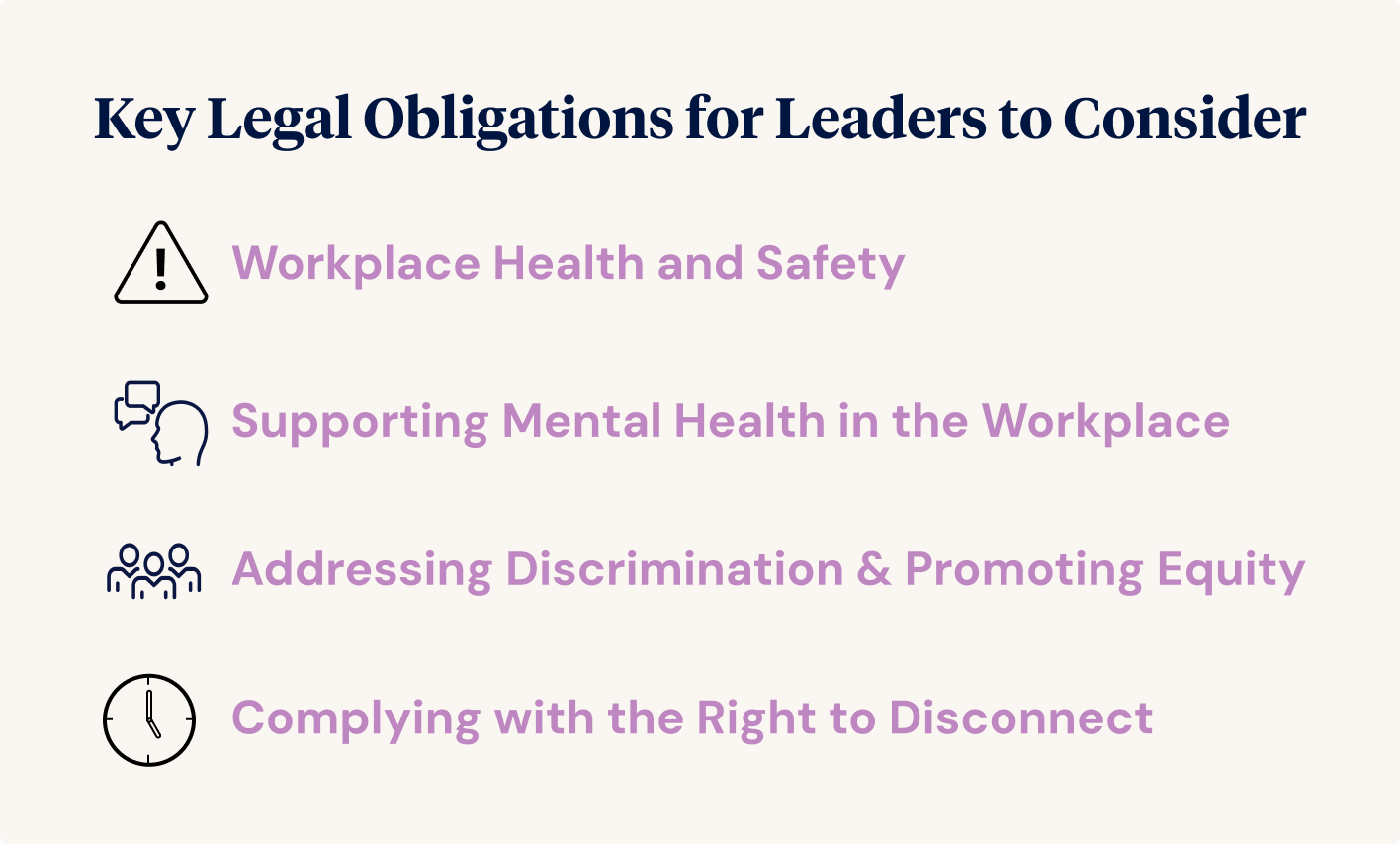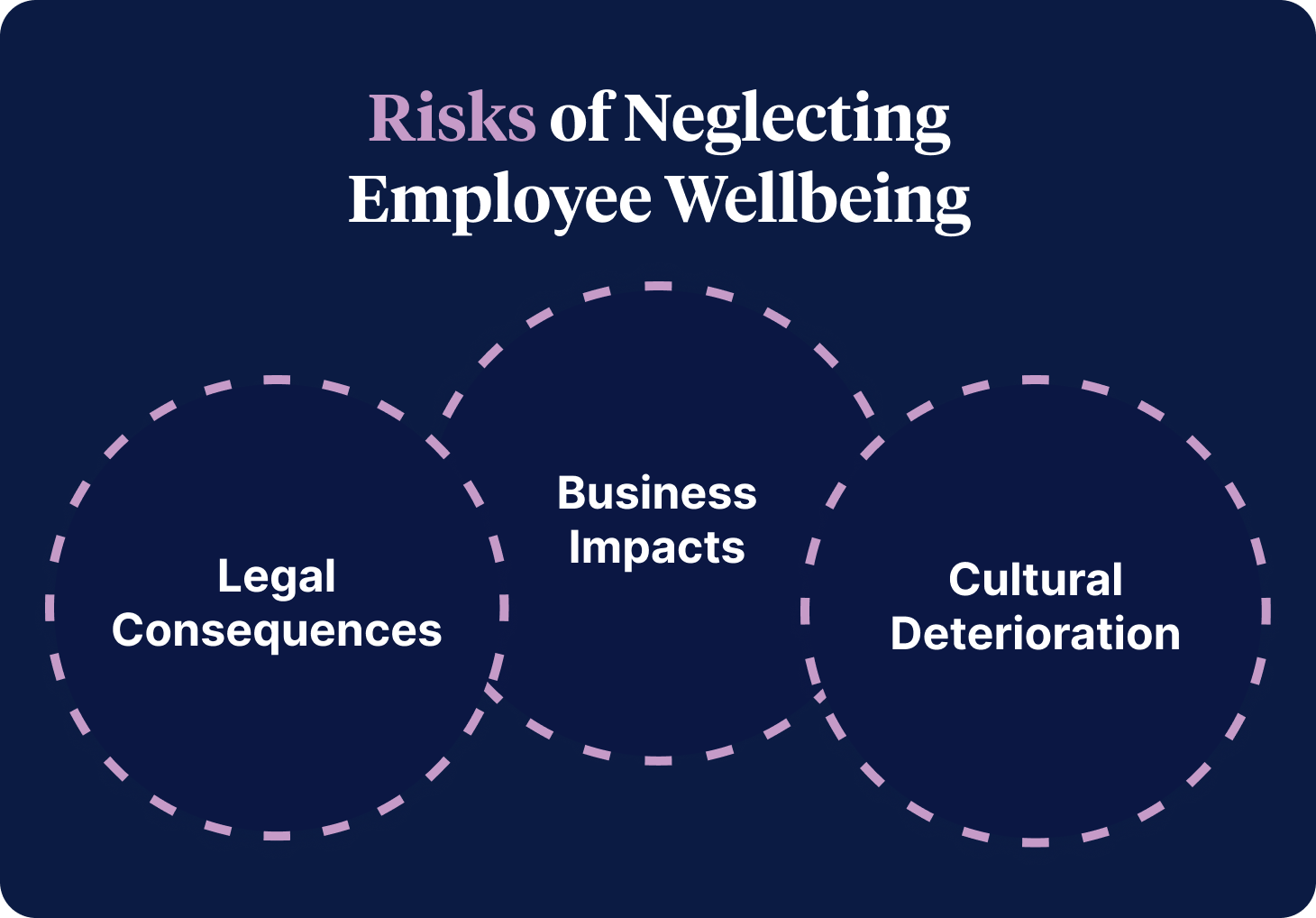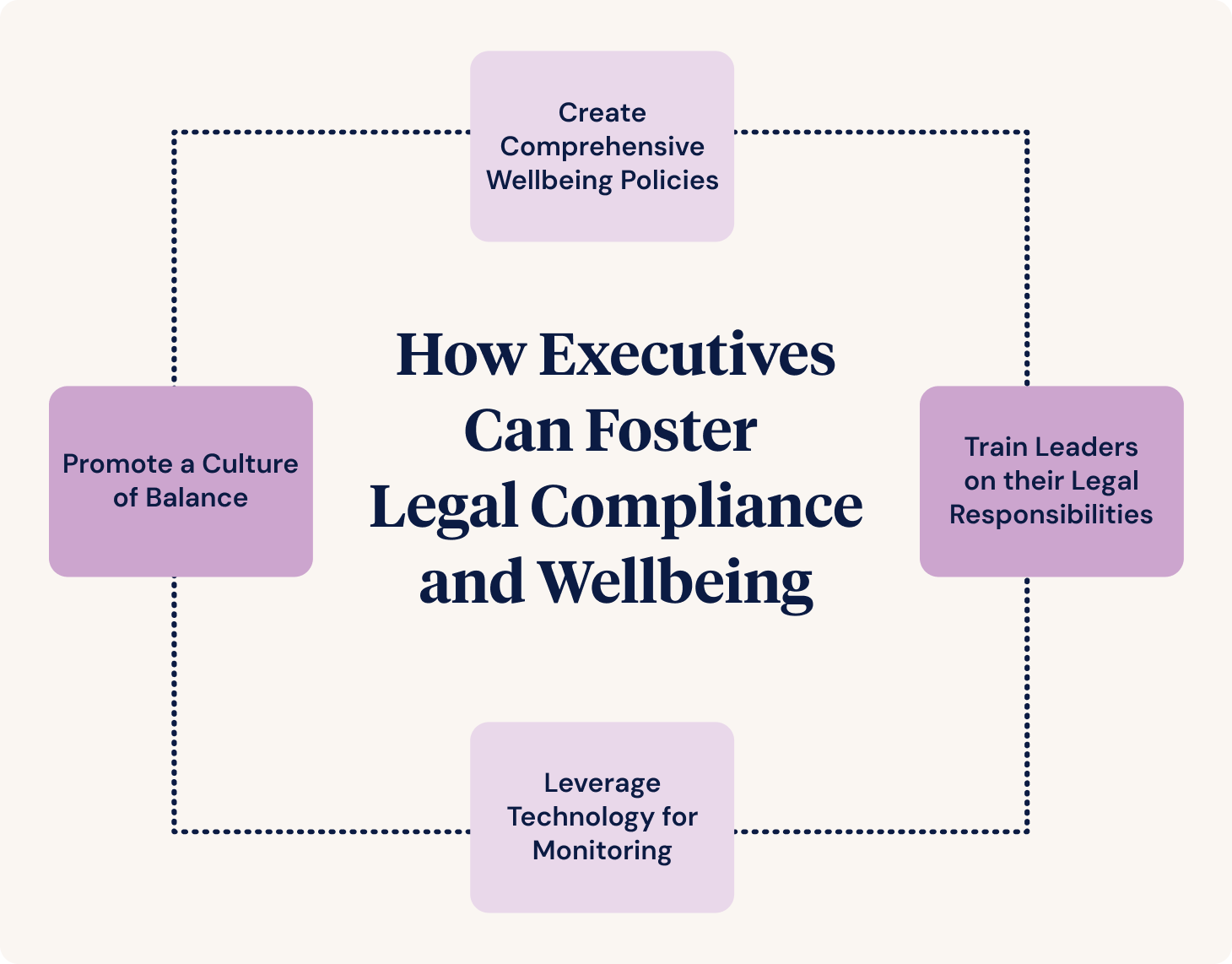Why Leaders Must Prioritise Employee Wellbeing
Employee wellbeing is no longer just a nice-to-have; it’s a critical component of organisational success and a legal obligation. Leaders play a pivotal role in ensuring that their organisation fosters a positive work culture and complies with the intricate web of workplace laws designed to protect employees.
In this guide, we explore the legal concepts underpinning employee wellbeing, the risks of neglecting this crucial area, and how you, as leaders, can take proactive steps to create a compliant, thriving workplace.
The Legal Definition of Employee Wellbeing
Employee wellbeing encompasses the physical, emotional, and mental health of workers. Legally, it goes beyond providing a pleasant work environment and includes specific obligations outlined by Australian workplace laws. These obligations require employers to:
- Ensure safe working conditions, as set out in the Work Health and Safety Act 2011 (WHS).
- Prevent discrimination and foster equity, as mandated by the Disability Discrimination Act 1992.
- Protect employees from workplace stress and burnout, aligning with WHS regulations on psychological safety.
- Provide reasonable leave entitlements, including sick and carers’ leave, under the Fair Work Act 2009.
Neglecting these responsibilities can lead to costly lawsuits, regulatory penalties, damage to reputation, and, more importantly, a negative impact on your organisation's morale.
Key Legal Obligations for Leaders to Consider
Key Legal Obligations for Leaders to Consider There are some key legal obligations for leaders to consider.

1. Ensuring Workplace Health and Safety
Workplace health and safety laws require employers to provide a safe environment for all employees. This obligation covers physical safety, such as preventing injuries from machinery or hazardous materials, and psychological safety.
For instance, leaders must address factors like excessive workloads, bullying, and toxic work environments, as these can lead to mental health issues. Regular safety audits and risk assessments are essential to identify and mitigate potential hazards. Training employees to recognise and report risks can also help prevent injuries or psychological harm.
Failing to meet these standards carries significant consequences. Under the WHS Act, organisations can face penalties of up to $3 million for non-compliance. Executives and directors may also be liable for penalties of up to $600,000 or 5 years in jail.
2. Supporting Mental Health in the Workplace
We know both anecdotally and statistically that mental health is a growing legal and organisational focus area. Safe Work Australia has highlighted the increasing prevalence of workplace stress, with mental health conditions accounting for a significant proportion of workers’ compensation claims. Safe Work Australia
Employers are legally required to create a psychologically safe workplace. This includes taking steps to:
- Recognise signs of stress and burnout.
- Provide accommodations for employees with mental health conditions, such as flexible working arrangements.
- Offer access to mental health support, like Employee Assistance Programs (EAPs).
For example, if an employee discloses that they are experiencing anxiety, the organisation must take reasonable steps to accommodate their needs, whether through adjusted workloads or extended leave. Ignoring such obligations can result in discrimination claims under the Disability Discrimination Act 1992.
3. Addressing Discrimination and Promoting Equity
The Disability Discrimination Act 1992 prohibits treating employees unfairly due to physical or mental disabilities. This law requires organisations to provide reasonable adjustments to enable employees to perform their roles effectively.
Leaders must ensure that recruitment processes, workplace policies, and performance evaluations are inclusive and fair. This obligation, however, goes beyond compliance. We know that by fostering equity within the workplace results in a more engaged and diverse workforce.
Discrimination cases can lead to costly lawsuits and severe reputational damage, making proactive equity measures a sound investment. Consequently, instead of ignoring the how potentially discriminatory practices within the workplace, embrace the power that equity can have on drive positive long term change.
4. Complying with the Right to Disconnect
The “right to disconnect” became law in Australia on 26 August 2024 following significant amendments to the Fair Work Act 2009. For small businesses, this employee right to disconnect comes into effect on 26 August 2025.
The 'right to disconnect' legislation regulates out-of-hours communication between employers and employees. Instead of banning all after-hours contact, it sets reasonable boundaries to protect personal time. This reflects the growing need for balanced work-life integration, especially as modern communication technologies blur the lines between professional and personal life.
For executives, this presents an opportunity to lead by example. Policies that limit after-hours communication can prevent burnout and promote work-life balance, creating a healthier workplace. Organisations might consider using email scheduling tools and encouraging leaders to model healthy boundaries.
Risks of Neglecting Employee Wellbeing
The consequences of neglecting employee wellbeing extend far beyond disgruntled staff. They can significantly impact an organisation’s legal standing, reputation, and financial health.

1. Legal Consequences
Organisations that fail to prioritise employee wellbeing may face penalties under WHS laws, compensation claims for psychological injuries, and discrimination lawsuits. These legal challenges are costly and damage an organisation’s ability to attract and retain talent.
For example, Court Services Victoria was fined close to $400,000 over a toxic workplace culture at the Coroners Court of Victoria that contributed to the suicide of one worker and numerous others taking stress leave.
2. Business Impacts
Neglecting wellbeing also leads to lower employee engagement, increased absenteeism, and high turnover rates. A workplace perceived as uncaring or unsafe can tarnish an organisation’s employer brand, making it harder to compete for top talent.
3. Cultural Deterioration
A lack of focus on wellbeing often results in a toxic work culture. Employees who feel unsupported may disengage, spreading negativity and harming organisational productivity.
How Executives Can Foster Legal Compliance and Wellbeing
Executives are uniquely positioned to drive change and ensure compliance with legal obligations while creating a positive work environment.

1. Crafting Comprehensive Wellbeing Policies
Policies should address all aspects of wellbeing, including physical safety, mental health support, and the right to disconnect. For example:
- A policy on psychological safety might include clear guidelines on recognising and reporting stress.
- A leave policy should explicitly state entitlements for carers’ leave or mental health days.
- A right to disconnect policy should explicitly state when and in what circumstances employees can be contacted outside of regular working hours.
2. Train Leaders on Legal Responsibilities
Leaders at all levels must understand their role in upholding workplace laws. Training managers to recognise signs of stress or mental health challenges and respond appropriately is essential. This training should also cover anti-discrimination laws and the importance of equity in decision-making.
3. Promote a Culture of Balance
A culture that values work-life balance can prevent many wellbeing issues before they arise. For example, leaders and their human resources teams can lead initiatives that encourage regular breaks, flexible work arrangements, and transparent communication around workloads.
4. Leverage Technology for Monitoring
Technology can help leaders monitor wellbeing trends and identify potential risks. Regular employee surveys, pulse check-ins, employee assistance programs, and feedback platforms provide valuable insights into how employees are feeling and enable timely interventions.
Conclusion
Investing in employee wellbeing is not just a legal requirement - it’s a strategic advantage. Organisations that foster safe, inclusive, and balanced work environments see improved engagement, lower turnover, and higher productivity. These benefits directly contribute to long-term success.
If you’re interested in this topic, learn more about the links between mental health and productivity.
References
- Psychological health and safety in the workplace - Safe Work Australia
- Leave entitlements under the Fair Work Act 2009 - Fair Work Ombudsman
- Affordable Employee Assistance Programs - Talked - Talked
- What Is Psychological Safety? - Harvard Business Review
- Create a mentally healthy workplace - Business.gov.au
- The right to disconnect - LexisNexis
Author
Vincent Lau
Vincent Lau is the Co-Founder and Head of Operations at Talked, Australia's leading online mental health and psychology platform. With a background in corporate law, Vincent brings a unique perspective on how Australians engage with mental health services. He is passionate about delivering consumer-centric care and improving access to mental health support.
Leveraging his expertise in strategy development, project management, and thought leadership, Vincent drives impactful change both at Talked and within the community, focusing on creating positive outcomes for all patients.



